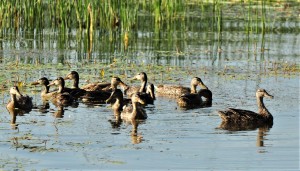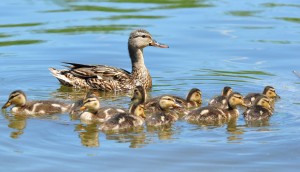Photography courtesy of Lowell Washburn, all rights reserved.
When leaves fall and autumn winds blow, Iowa duck hunters can anticipate a strong migration of southbound waterfowl during 2017. That’s the official assessment from this year’s North American Breeding Duck and Habitat Survey released today by the U.S. Fish & Wildlife Service.
Conducted every year since 1955, the continent-wide annual survey measures trends in duck breeding populations and monitors wetland [pond] indexes across the northern U.S. as well as for large portions of prairie and boreal Canada. This year, a total of 47.3 million breeding ducks were inventoried during spring surveys – a count similar to last year’s and 34 percent above the 1955-2016 Long Term Average [LTA]. Spring pond counts on Canada’s southern prairies were up 24 percent from 2016 and were 23 percent above the LTA. Pond counts increased 42 percent in the eastern Dakotas. The combined pond counts for the north central U.S. was up 22 percent from last year and are 17 percent above the average.
Species Highlights: A surveyed breeding population of around 10 million mallard ducks was reported by the Fish & Wildlife Service during 2017 – an 11 percent decrease from last year’s count, but 34 percent above the LTA. Blue-winged teal populations jumped 18 percent from 2016 and are currently 57 percent above the LTA. The combined breeding populations of lesser and greater scaup [bluebills] declined 12 percent and are 13 percent below the average. The number of breeding pintails was similar to 2016 and remains 27 percent below the LTA.
In Iowa, spring water levels were at or above crest on most wetlands. Overall, duck and goose production ranged from good to excellent and anticipation is beginning to mount as the fall countdown begins. This year’s waterfowl seasons begin with a special teal season which opens on September 2.
But in spite of this year’s positive waterfowl forecast, Iowa hunters are advised not to count their ducks until they’re hovering over the decoys. For those of us sitting smack in the middle of the flyway, there are always plenty of uncertainties. Although Iowa marshlands were at flood stage this spring, recent droughts have left many marshes in poor condition. Some of our shallower basins are completely dry. Waterfowl, along with every other type of wetland wildlife, are in dire need of substantial rainfall.
As always, the ultimate success of the fall duck season will depend on local wetland conditions, developing fall weather patterns and, of course, upon the migratory whims of the birds themselves. One fact is certain though. When the temperatures plummet and northern wetlands begin to freeze, an estimated fall flight of 100 million ducks will come winging down the flyways. It’s a forecast that is sure to stir the blood of any duck hunter.
LW
Aug. 16, 2017



 Tom Cope
Tom Cope Sue Wilkinson
Sue Wilkinson Susan Judkins Josten
Susan Judkins Josten Rudi Roeslein
Rudi Roeslein Elyssa McFarland
Elyssa McFarland Mark Langgin
Mark Langgin Adam Janke
Adam Janke Joe Henry
Joe Henry Kristin Ashenbrenner
Kristin Ashenbrenner Joe Wilkinson
Joe Wilkinson Dr. Tammy Mildenstein
Dr. Tammy Mildenstein Sean McMahon
Sean McMahon